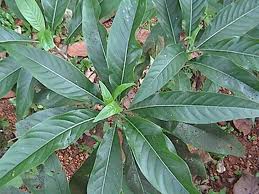Agriculture

Cultivation
- Medicinal Plant- Aryaveppu / Neem, Margosa
Aryaveppu Common name: neem, margosa Scientific name: Azadirachta indica A. JUSS. Parts used: Leaves, Flower, Oil, Seed. Commercial importance: It acts as vermifuge, insecticide, astringent, tonic and antiseptic. It possess anti diabetic,...
- Medicinal Plants- Amruthu/tinospora
Common name: Gulancha tinospora, Tinospora Scientific name: Tinospora cordifolia (WILLD.) HOOK.F. & THOMS. Parts used: stem Commercial importance: amruthu acts as a diuretic and found to be effective against Renal obstruction like...
- Medicinal Plant- Amukkuram/ Indian Ginseng
Common name: Winter cherry, Indian Ginseng Scientific name: Withania somnifera (Linn.) Dunal. Parts used: Roots and Leaves Commercial importance: The root of Asvagandha is used in the form of powder to treat consumption, excessive emaciation,...
- Medicinal Properties Of Adacka/ Arecanut, Betel Nut
Scientific Name: Areca catechu L Parts used: Inflorecsence, seeds Commercial importance: Areca Nut is aromatic and astringent and is said to intoxicate when first taken. Areca Nut is made into a dentifrice on account of its astringent properties. Catechu...
- Medicinal Plants In Kerala
Kerala forests are rich with a variety of medicinal plants that usually find its way to several ayurvedic medicines. From down south Agastyarkoodam to northern Nilamboor, there are different forests, which provide a rich supply of Kerala medicinal plants....
Agriculture
Medicinal Plant- Adalodakam/ Vasaca small
Common name: Vasaca small, Malabar Nut
Parts used : Whole plant, Leaves and roots of the plant are medicinal. Leaves contain two major alkaloids called vasicine, and vasicinone.
Commercial importance: Plant is used for treating pitta, kapha, cough, bronchitis, asthma, inflammation, hemorrhage, hemorrhoids, diseases of eyes, bleeding and diarrhea. Fresh or dried leaves of the plant constitute the drug Vasaka and are used for bronchial troubles and consumption. Leaf juice is used for glandular tumours. It is also prescribed commonly for local bleeding due to peptic ulcer, piles etc. Its local use gives relief from pyorrhoea and bleeding gums. Powdered leaves are used for skin troubles
How to cultivate:
Cultivation
Soil and climate
Though the crop grows in a variety of climatic and soil conditions, alluvial soils are best suited for raising the crop. The plant is tolerant to shade but is susceptible to water logging. It can be cultivated either as a pure crop or as an intercrop in coconut and rubber plantations in the initial 3-4 years.
Propagation
Adhatoda is propagated by tender stem cuttings. Stem cuttings of 15-20 cm long and 3-4 nodes are ideal for planting. It is better to root the cuttings in nursery before transplanting in the main field. Nursery preparation can be done in March-April. For this, the tender stem cuttings are planted in poly bags filled with farm yard manure, top soil and sand in the ratio 1:1:1. Cuttings will root readily and will be ready to transplant to main field after two months.
Planting
Rooted cuttings of adhatoda can be planted on mounds or on ridges. Plough and level the main field thoroughly and ridges or mounds are prepared 60 cm away from each other. With the commencement of rainfall, rooted cuttings are planted on the ridges with a plant to plant spacing of 30 cm. If grown on mounds, up to 5 cuttings may be planted on a single mound. In sloppy areas cuttings are planted directly by making pits with a sharp pole. Adequate care should be taken to prevent water logging as it may promote rotting.
Manures and fertilizers
Apply organic manure in the form of FYM, compost or green leaf at the rate of 10 t/ha as basal dressing. Apply N:P:K each at the rate of 50 kg/ha. Entire P should be given basally and N and K may be given in two equal splits. Keep the field free of weeds and give earthing up after topdressing with fertilizers.
Harvesting
Leaves, roots and stem of adhatoda are of medicinal value. Leaves can be harvested from the first year of planting itself; but roots will be ready to harvest only two years after planting. December-January is the ideal time for harvesting adhatoda. In the second year, the entire plant is harvested and roots are carefully dug out wholly without damage by carefully removing soil. Harvested roots are cleaned and marketed either in fresh form or after drying. Total yield of root, stem and leaves from one hectare of area will be 12.5 tonnes.
- Medicinal Plant- Aryaveppu / Neem, Margosa
Aryaveppu Common name: neem, margosa Scientific name: Azadirachta indica A. JUSS. Parts used: Leaves, Flower, Oil, Seed. Commercial importance: It acts as vermifuge, insecticide, astringent, tonic and antiseptic. It possess anti diabetic,...
- Medicinal Plants- Amruthu/tinospora
Common name: Gulancha tinospora, Tinospora Scientific name: Tinospora cordifolia (WILLD.) HOOK.F. & THOMS. Parts used: stem Commercial importance: amruthu acts as a diuretic and found to be effective against Renal obstruction like...
- Medicinal Plant- Amukkuram/ Indian Ginseng
Common name: Winter cherry, Indian Ginseng Scientific name: Withania somnifera (Linn.) Dunal. Parts used: Roots and Leaves Commercial importance: The root of Asvagandha is used in the form of powder to treat consumption, excessive emaciation,...
- Medicinal Properties Of Adacka/ Arecanut, Betel Nut
Scientific Name: Areca catechu L Parts used: Inflorecsence, seeds Commercial importance: Areca Nut is aromatic and astringent and is said to intoxicate when first taken. Areca Nut is made into a dentifrice on account of its astringent properties. Catechu...
- Medicinal Plants In Kerala
Kerala forests are rich with a variety of medicinal plants that usually find its way to several ayurvedic medicines. From down south Agastyarkoodam to northern Nilamboor, there are different forests, which provide a rich supply of Kerala medicinal plants....
